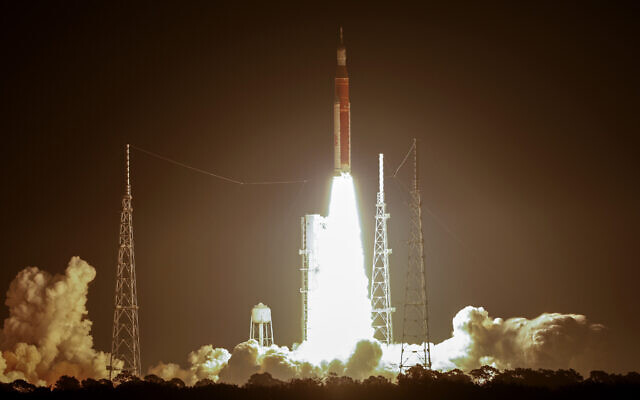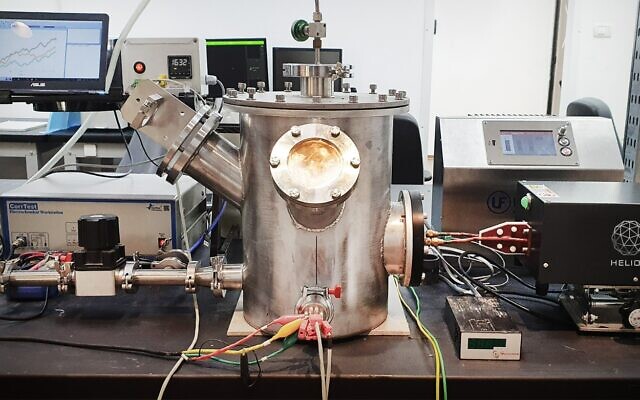Israeli pens plan for belt of solar panels on moon to power oxygen production
NASA’s unmanned Artemis mission to the moon last month represented a small step toward the eventual dream of getting people to Mars and beyond, a goal that will require a giant leap in finding ways to settle and exploit the resources of earth’s lone satellite.
In two years, the Artemis project — joined by more than a dozen countries, including Israel — will fly astronauts around the moon, and if all goes according to plan, 2025 will see the first crewed lunar landing since Apollo 17 in 1972.
By the middle of the next decade, the US National Aeronautics and Space Administration plans to populate its first permanent base camp for rotating research teams.
To make this possible, a key challenge will be mining and separating the metals and oxygen bound together in the stony deposits called regolith that cover the lunar surface, and generating the energy to power that process.
NASA and the US Energy Department are working on advance space nuclear technologies, according to the administration’s website. It notes that “fission systems are reliable and could enable continuous power regardless of location, available sunlight, and other natural environmental conditions. A demonstration of such systems on the moon would pave the way for long-duration missions on the Moon and Mars.”
Get The Times of Israel’s Daily Edition
by email and never miss our top stories
By signing up, you agree to the terms
As an alternative, a US-born Israeli academic has designed a conceptual plan to rig the moon with solar panels.
Emeritus Professor Jeffrey Gordon of Ben-Gurion University’s Solar Energy and Environmental Physics Department has calculated that this would require six times less mass than the best nuclear option to provide the same amount of electricity.
He claims that his proposal would provide uninterrupted electricity supply for oxygen-producing facilities 100% of the time, with a sufficient number of panels always exposed to the sun.
Gordon published his vision in the academic journal Renewable Energy earlier this year and was subsequently invited to lecture at NASA’s John H. Glenn Research Center in Cleveland, Ohio.
“We discussed it and it was stimulating,” Gordon said, explaining that solar researchers at the Glenn campus were competing with other scientists pushing for a nuclear solution.
“NASA wants a reliable, long-lifetime, minimum mass system,” he said. “Reliability comes even before cost.”
At the initial stage of human colonization, only small amounts of energy will be needed, and NASA has already selected six companies to come up with proposals, three based on solar energy and three employing nuclear fission.
With the longer term in mind, though, NASA will need larger amounts of energy to extract water — which exists on the moon in various states — and mine the lunar surface for metals to be used for lunar construction, and separate those metals from oxygen, which makes up around 45% of the stony deposits.
Gordon’s research started when he was approached a couple of years ago by an Israeli startup, The Helios Project, which is designing a lunar oxygen-producing reactor with a technology that requires very high temperatures.
A joint approach for funding from the Israeli Innovation Authority didn’t bear fruit, and the partnership stopped — but not before Gordon had penned his conceptual plan for a belt of solar panels on the moon.
Emeritus Professor Jeffrey Gordon in his laboratory at Ben Gurion University’s Solar Energy and Environmental Physics Department. (courtesy)
Oxygen extracted from the lunar regolith will serve human needs but be used mainly to fuel and refuel rockets and orbiting satellites.
Today, rockets must be loaded with enough liquid oxygen and hydrogen to provide them with the propulsion to get to space and back to Earth.
With around $1 million currently needed for every kilogram of payload, costs could be slashed were it possible to provide oxygen at lunar filling stations.

NASA’s new moon rocket lifts off from Launch Pad 39B at the Kennedy Space Center in Cape Canaveral, Florida, November 16, 2022. This launch is the first flight test of the Artemis program. (AP Photo/Terry Renna)
Before he began, Gordon reviewed three options, one of which was nuclear, though as an expert on solar energy he was looking to develop a solar alternative. The benchmark was producing energy around the clock.
The two solar options — generating solar energy while the sun shines and storing it in batteries during periods of darkness, or building twice as many solar plants as needed and operating each one only half of the time — turned out to be prohibitively expensive.
“I developed a concept and performed all the quantitative estimates that an engineering staff at a space agency would want to review,” Gordon explained.
His plan would see a ring of solar panels installed close to one of the lunar poles; he used the north pole for illustration. They would be located no higher (or lower, in the case of the south pole) than the 88th latitude, to balance the advantage of a relatively short lunar circumference in these regions with the need to make sure that the shortest daylight periods still satisfied the power demands.
The oxygen-making factories would be located around 10 kilometers (six miles) closer to a pole. This would maintain a sufficient distance to prevent lunar dust generated during mining from covering the photovoltaic panels, but still keep transmission lines relatively short.
The transmission lines themselves would not require any insulation, Gordon pointed out, because the lunar ground provides natural electrical insulation.
Experiments testing the strength of photovoltaic panels in the face of cosmic radiation looking promising, Gordon added. “PV should be able to survive cosmic radiation long enough to satisfy what’s needed,” he said.
But the greatest concern — and the one preoccupying NASA — was how to sufficiently protect humans operating the oxygen factories and carrying out other tasks. “There’s no answer to that yet,” he said.
Gordon said he had “no opinion” about potential risks of building nuclear reactors on the moon, and noted that nuclear fuel could easily last for 100,000 years, although turbines and generators would degrade within decades.
Dealing with the nuclear waste was a “good question,” he conceded, adding, “There would be nuclear pollution.”
He went on, “At this time, my impression is that NASA is planning nuclear reactors on the moon in the long term and that the solar people are trying to persuade them otherwise or at least to have the two technologies,” he said.
His own plan was still “on the far horizon.”
NASA did not provide any response by press time.

A prototype lunar oxygen production unit that works under vacuum conditions in the laboratory of The Helios Project. (Courtesy, The Helios Project)
The Helios Project, which last year signed a memorandum of understanding to cooperate with Ispace Inc of Japan, hopes to fly a small prototype of its oxygen factory to the moon in 2025.
The plan is to produce a few dozen grams of oxygen to show proof of concept, according to Jonathan Geifman, Helios co-founder and CEO. To do this, a battery will probably be used.

Jonathan Geifman, Helios co-founder and CEO (courtesy)
Geifman said the eventual aim was to produce 1,000 tons of oxygen per month — enough to refuel the SpaceX Starship. Powered by liquid oxygen and liquid methane, the Starship would be “the main workhorse for all activity in the near future.”
Israel launched its own lunar landing capsule, Beresheet in 2019. Due to a technical glitch, the vessel crashed on landing.
Earlier this year, former Israeli fighter pilot Eytan Stibbe became the second Israeli in space, paying the privately owned Axiom Space to join three others in flying to the International Space Station.
Israel’s first astronaut, Ilan Ramon, was killed in 2003 when the space shuttle Columbia disintegrated while reentering the atmosphere, killing all seven crew members on board.



Comments are closed.